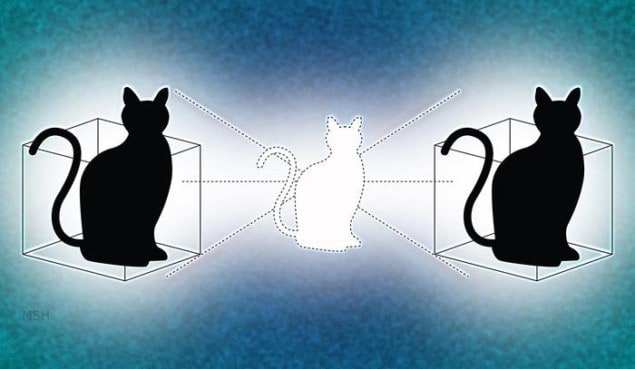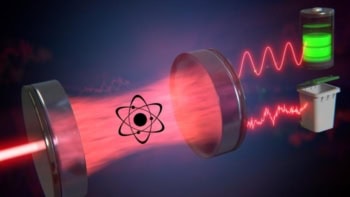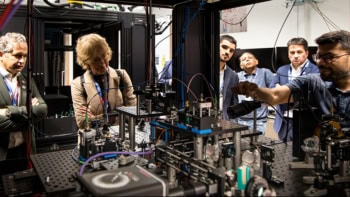
Schrödinger’s cat now has a second box to play in, thanks to an international team of physicists that has created a two-mode “Schrödinger’s cat state” for the first time. The experiment brings together two purely quantum properties, in that the “cat” (i.e. the photons) is simultaneously “alive and dead” (in a superposition of states) while also in two locations at once (the two boxes are entangled with one another).
The experiment is a step towards creating the larger and more sophisticated quantum states that are necessary to make quantum computing a reality. The team says that the work also demonstrates a two-logical-qubit system with in-built quantum error correction, making it a great resource for quantum metrology and quantum-communication networks.
Quantum cats
The famous Schrödinger’s cat paradox, first proposed in 1935, is based on one of the most basic tenets of quantum mechanics – superposition. This arises because a microscopic particle such as a photon is considered to simultaneously be in all possible “states” (or spatial positions in this experiment) until a measurement is made and its wavefunction collapses. In the real “classical” world, however, macroscopic objects such as cats do not exist in a superposition of states. This is usually explained in terms of “decoherence”, whereby a state loses its coherent quantum nature thanks to interactions with the environment. However, just where the boundary between the classical and quantum worlds lies is still a bit of a mystery.
Today, physicists can create multiparticle systems made up of many photons that are collectively in a superposition of two very different or extreme states. These are known as “Schrödinger’s cat states” and are easily distinguishable from each other. These systems can be achieved in the lab using harmonic oscillators. The oscillation of a microwave field, for example, can be thought of a swinging pendulum and the two different states are equivalent to the pendulum at the far left or right of its swing. In a cat state, the pendulum is at both distinct positions at once. Such harmonic oscillators are preferable to using atoms to create the two extreme states because the two swing positions are far more distinct and are separated by a distance that can include large numbers of intermediate states.
Two become one
To make a two-mode cat state, Chen Wang and colleagues at Yale University in the US, together with colleagues in France, used not one, but two harmonic oscillators based on microwave cavities. Here, the live cat corresponds to the microwave field in both cavities swinging in the positive direction, while the dead cat corresponds to the field swinging in the negative direction. This quantum combination of macroscopic multiparticle superposition states and entanglement was first proposed in 1993, but this is the first time it has been experimentally achieved.
The team’s device is made up of two, 3D microwave cavities and a monitoring port – all connected by a superconducting, artificial atom. The “cat” itself is made of confined microwave light in both cavities. The cavities were fabricated out of high-purity bulk aluminium and a sapphire chip with a micro-fabricated electric circuit was inserted into the aluminium package, which is connected using conventional microwave cables.
A measurement is made by transmitting microwave signals from room-temperature electronics through the device package – this signal indirectly informs the quantum state of the cavities. There are up to a few tens of photons in each cavity.
Wang tells physicsworld.com that his team’s method “differs from previous cat-state experiments in that we have two cavities carrying the cat state and therefore require measurements that can jointly probe the state of two cavities, which is a new development”. He adds that the team’s method also varies “from many other experiments dealing with the quantum state of microwave or optical photons, in that we operate on a quasi-classical state of microwave photons (coherent state) instead of individual photons, which allows us to easily access large number of photons”.
The distinguishability between the two states – which is a crucial factor – is determined by charting the states on a “phase space” map and measuring their distance in terms of how many possible states lie between them. Just how big the distinguishability distance must be before the state can be classified as “macroscopic” is still fairly subjective. In the current experiment, this distance is usually 30 photons, extending up to a maximum of 80 photons – Wang describes this as “more macroscopic than the few photons people typically deal with in our field, but certainly less macroscopic than a real cat”.
Different strokes
The results of the experiment can be interpreted in two different ways, according to the researchers. They describe the cat as “living in two boxes” by defining the joint state of the two cavities as the state of the cat (+ + is alive, – – is dead). In this case, by definition, the cat is in both boxes simultaneously. “This cat is big and smart. It doesn’t stay in one box because the quantum state is shared between the two cavities and cannot be described separately,” says Wang. An alternative view emerges if you consider the state of each cavity individually by performing single-box measurements. In this case, the team has two small and simple Schrödinger’s cats – one in each box – that are entangled.
Wang’s team says that the experiment has potential applications in quantum computation – especially as the cat states operate as fault-tolerant qubits. This is because information is redundantly encoded in the states using many degrees of freedom. “It turns out cat states are a very effective approach to storing quantum information redundantly, for implementation of quantum error correction,” says team-member Robert Schoelkopf, director of the Yale Quantum Institute. “Generating a cat in two boxes is the first step towards logical operation between two quantum bits in an error-correctible manner.”
The research is published in Science.



